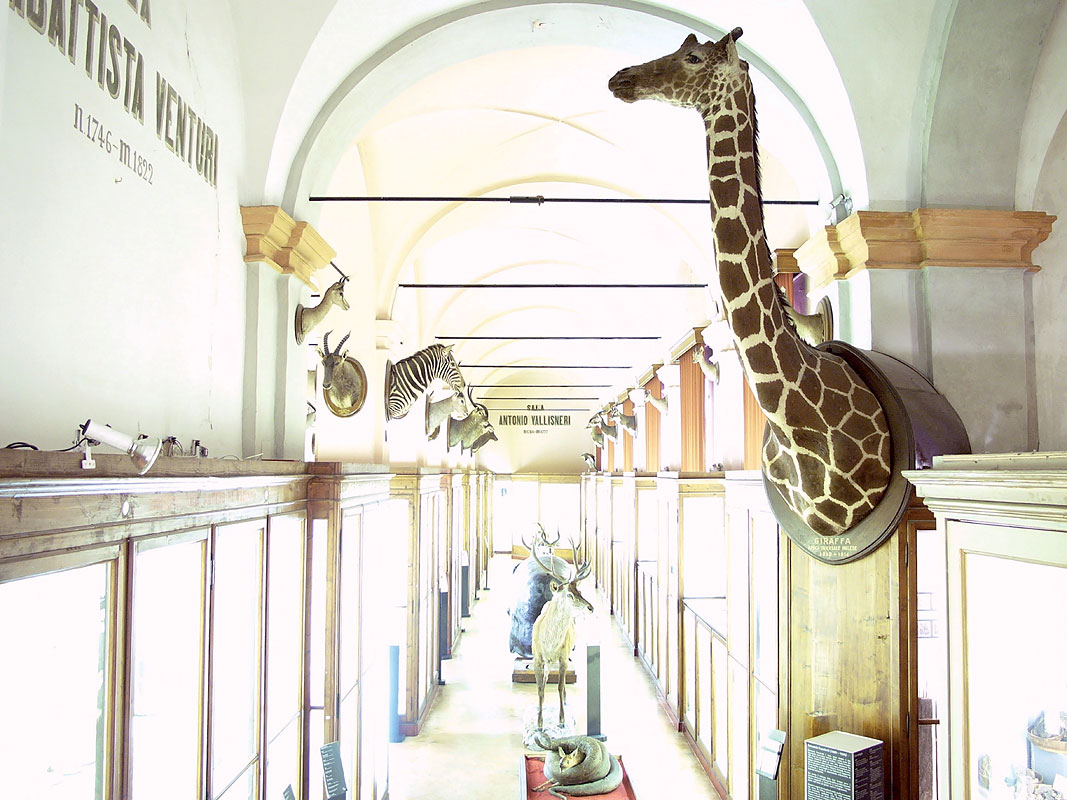Zoology
Zoologia
The zoological collections in the Musei Civici are mainly hosted in the hall named after Antonio Vallisneri, where zoological finds were included that had been acquired subsequent to the Spallanzani Collection and which were definitively separated during a rearrangement effected by Alfredo Jona (1888). The original nucleus of materials from the 1800s was supplemented in the 1900s by the abundant collection of Africantrophies of Baron Raimondo Franchetti (1889-1935), an explorer from bReggio. It includes the busts of numerous antelopes and gazelles, and of other animals such as the zebra, giraffe, elephant, warthog, and dromedary, several skins (worth special mention are those of a black rhinoceros and a polar bear) and various whole-body specimens, including a large example of a Nile crocodile and a reconstruction of scenes of predationon the African savannah. Most of the Franchetti’s trophies are hung at the top of Vallisneri Hall, but some are also on display in the Ethnographyhall. Also displayed here is the recent (2009) Ansaloni donation of African artiodactyls.
Materials selected from old collections and supplemented with new acquisitions are arranged since 1997 in a systematic sequence (even though the sequence for certain classes is incomplete) in showcases extending around the hall. The display begins with an exhibit of invertebrates that includes arthropods, mollusks andechinoderms. Next come the amphibians, consisting of diverse frogs, toads, newts and salamanders, followed by reptiles represented by specimens of crocodile, tortoise and a host of snakes. The showcases containing birds are the most teeming of all and show numerous specimens of anatidaeand diurnal birds of prey, as well as a nandu and a large pelican. Elegant peacocks and pheasants fill several show cases with feathers and colors, while the packed arrangement of the smaller, often exotic, specimens recalls the antique display method that once characterized the museum in centuries gone by. A collection within a collection consists of numerous specimens of the domestic “triganino” pigeons traditionally raised in the local area. Mammals fill the remaining showcases, first with the more primitive and curious forms, such as the platypus, the pangolin and the echidna, and then with more usual species, until we reach the showcases ofthe primates, which host various examples of our closest relatives. Outside the showcases, you can admire an original preparation of a sperm whale (which was executed, as were many others, by Socrate Gambetti in the 1940s) that reached Reggio after washing up on the Adriatic coast. The animal not only represents the systematic order of cetaceans, but has become one of the symbols of the museum over time.
A collection of fauna from the Reggio area is presented in the central showcases in the hall (except for large specimens of fallow deer and deer, which are externally placed). The assortment consists of recently acquired specimens, but does not include the longstanding finds on display in the entomological exhibit. In the layout, the fauna population in the provincial area has been interpreted from the ecological standpoint, with animal communities from seven environments – from the Apennine ridge to the Po – brought to light. Because their conditions do not sustain tree coverage, the mountain top environments host species which find refuge on the ground, in the grasses of the meadowlands, in rocky ravines or in dens. Of these species, worthspecial mention are the snow vole (a relictual Alpine species) and the marmot (introduced in recent times), which both represent an inviting opportunity for the golden eagle. The beech wood forests on the mountain ranges extending from 800 to 1000 meters in altitude are frequented by roe, boar and various carnivores such as the wolf, an animal that has recently reappeared in our Apennine chain. The presence of flying animals is diversified in the hills and midmountainareas, among the oak and chestnutgroves. One can find both diurnal birds such asthe buzzard and the sparrow-hawk, and nocturnal fowl that include owls, owlets, horned owlsand nighthawks. Among the larger mammals, the most important are badgers, foxes and porcupines. The smaller mammals comprise beechmartens, squirrels, hedgehogs and wild mice. Roes and moufflons have now become numerous, free populations after transcending their original captivity. The environments in the countrysidep resent the typical ecology of the plain, wherehen-pheasants, grey partridges and hares share the meadows and cultivated lands with granivore birds and rodents, while corvids and night herons populate the poplar groves. With regard to the urban environment, species are displayed that live in close proximity to humanity, particularly birds such as sparrows, pigeons and collared doves, but also rats, moles and owlets. Fauna from wet environments is subdivided into those that live in running water and those that frequent bodies of water. Numerous and well-diversified, it is here represented by elegant herons, by other muddwelling birds with curious beaks, and by the otter, which has since disappeared. One can also see animals that were not originally present, introduced into the area by Man, such as the nutria. They have adapted so well that they have become intrusive and even dangerous to the ecosystems that host them.
address
via Spallanzani, 1
42121 Reggio Emilia
T. +39 0522 456816
offices
via Palazzolo, 2
42121 Reggio Emilia
T. +39 0522 456477
F. ’39 0522 456476

